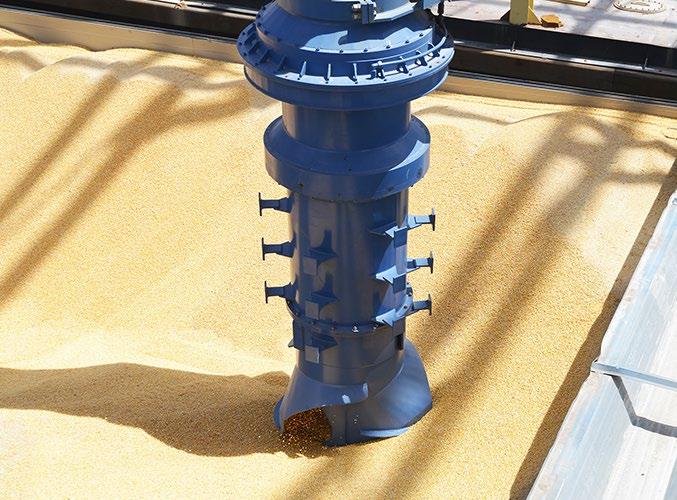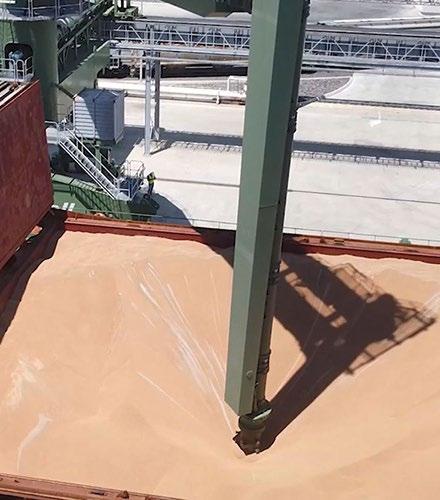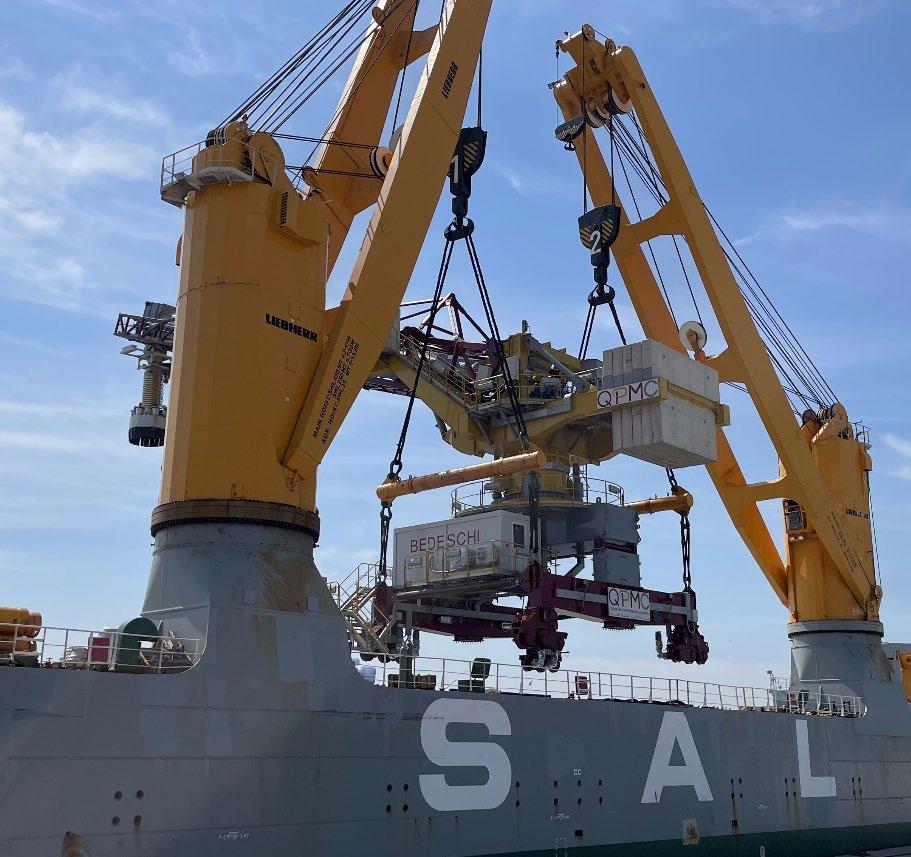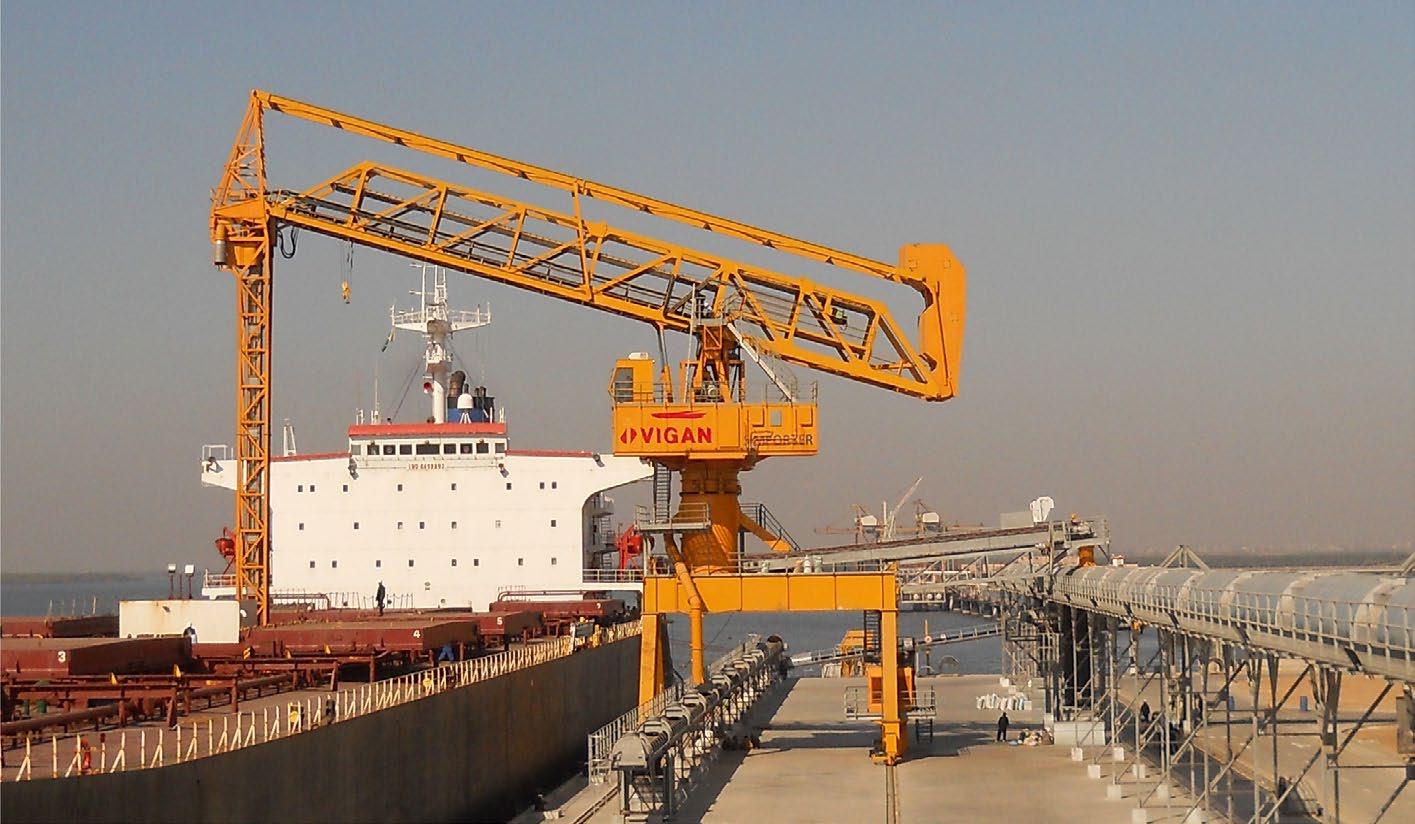
15 minute read
grain handling
from BTI Summer 2022
by Maritime-AMC
GROWING MARKET
Demand for efficient, cost-effective grain handling equipment has increased dramatically over the past few years, driven by the expansion of the grain trade
Grain is now the third largest cargo that Bruks Siwertell’s equipment handles, according to Per Hansson, sales director for EMEA and Latin America at the company. He estimates that the company’s ship unloaders have enabled operators to cut days unloading by up to 50%, reducing time spent in berth and increasing annual intakes.
“But we have not stopped here,” he says. “A recent innovative research and development programme, targeted at improving the lifetime of the vertical screw conveyor and its component parts, has yielded extremely positive results, which are now applicable to Bruks Siwertell’s entire portfolio of screwtype equipment, including Siwertell ship unloaders, loaders and conveyors. Grain handlers look set to significantly benefit from the developments.”
He adds: “By dramatically improving the service life of wear parts, customers save money on throughlife maintenance, without increased investment costs. Furthermore, the environment benefits from a more sustainable approach.
“Grain handlers have to meet some of the most challenging dry bulk material requirements. Import and export
terminals are subject to massive surges in intake from the seasonality of crop harvests. Their dry bulk equipment must match these, and offer consistently high capacities for maximum profitability, but also maintain the quality of shipments through sensitive handling.”
Siwertell screw-type ship unloaders can discharge grain and other agri-bulk commodities at rated capacities up to 1,800t/h.

BRUKS SIWERTELL HAS EFFICIENT LOADERS AND UNLOADERS
The company has grain, soya bean and soya meal handling systems operating in Brazil that run up to 4,000 hours per year. These systems work to some of the agri-bulk industry’s tightest seasonal schedules and there is no capacity for any unplanned downtime.
High-use conditions naturally have an inevitable impact on wear parts, Hansson says. “When combined with the remoteness of some operations, many of these customers often carry a large stock of critical spare parts, minimising the risk of unexpected stoppages.
“However, being able to offer longer screw conveyor lifetimes ensures a better balance between cost and component longevity, so we can meet the needs of this sector in a more effective way.”
Silo safety
Following on from collaborating with the Mineral Products Association (MPA) on new guidance for safer pressurised tanker deliveries, Hycontrol has now launched the updated Shield Lite silo protection system (SPS).
The revised SPS is smaller than previous versions, with all critical silotop safety components built in and prewired to provide simpler, easier and lower-cost installation. This design yields safe deliveries straight out of the box, cutting the chance of wiring mistakes.
Utilising purpose-designed pressure monitoring and control equipment, Shield Lite meets and exceeds current best practices, including those in the new MPA guidance. Powder storage silos are used across many industries but are at risk of over-pressurisation during tanker deliveries. Pressures as low as one psi are enough to rupture a silo or forcibly eject the filter unit from the roof.
Besides the physical danger and risk of fatalities from falling equipment, this can cause massive equipment damage and environmental pollution. A comprehensive, failsafe safety and control system is vital to prevent such disastrous outcomes. Shield Lite provides a fully-automated selftesting safety system that removes the risk of human error from the delivery process by thoroughly monitoring and controlling it.
The high-accuracy pressure safety components are pre-assembled and wired for simple installation. In addition, the system incorporates Hycontrol’s Ground Level Testing, through which a single key-turn activates a full-function test of all the crucial safety components without climbing the silo. Hycontrol managing director Nigel Allen says: “We have insisted for many years that simplicity is the key to safety, so we have made a system that will make a silo safe straight out of the box. With baked-in fail safes like ratio alarms, filter blockage warnings and driver delivery behaviour diagnostics, we can effectively eradicate the risk of human error.
“We understand that mistakes in maintenance and testing are inevitable. Our philosophy is to accept this and provide a system that monitors and safely alerts you when these errors occur. Safety for staff, contractors and drivers should always be the number one priority. As we say – safe silos are tested every time.”
Grain recalculation
A report by Reuters says sanctions-hit Russia has approved changes to the formula for calculating its grain export taxes to support shipment in the JulyJune marketing season, according to its agriculture ministry.
“Russian farmers are expected to harvest a massive wheat crop this summer, bringing a record exportable surplus in the 2022/23 season. However, shipments are complicated by high export tax, a strong rouble and sanctions-inflated costs for freight and insurance,” says Reuters.
The new base price for calculating the wheat export tax is set at 15,000 roubles ($283.68 at the current rate) per tonne, the ministry says.
“It was previously in US dollars at $200 a tonne. The Agriculture Ministry used the base price as well as price indicators reported by traders to determine the level of tax on a weekly basis. It is set at $146.1 per tonne for June 29 to July 5,” Reuters explains.

packing dangers
Improper packing of bulk grain cargo can lead to the distortion of the container, compromising structural integrity, spillage of contents, contamination, and injury to workers when opening container doors, the TT Club has warned.
“Containers are an increasingly popular, cost-effective method for the transport of bulk commodities such as grain. While there are efficiencies in transporting grain in containers, standard general purpose ISO containers are not designed to carry bulk cargoes, meaning additional procedures are required to do so safely.”
According to the club, dangers include issues including: » Distorted (bulged) containers that can lose their structural compressive strength. When stacked on board ships or at container terminals, there is an increased risk of stack collapse in extreme cases. Distorted containers can cause damage to a container ship’s cell guides and adjacent units, resulting in delays to cargo operations. » Where false bulkheads and labelling have not been utilised, personnel opening and discharging the container may be crushed as the bulk cargo bursts out of the container upon opening the doors. » Containers may be overweight or overloaded, given the dense properties of grain; capacity is restricted by mass rather than volume. The container, when fully packed with the cargo being transported, should not exceed the rated maximum gross mass of the unit (to ensure that it is not overloaded) as well as any intermodal weight restrictions applicable through the entire journey (when the unit would be overweight). » Eccentric load distribution, most commonly caused through inappropriate filling operations but also potentially during rough intermodal movements or handling, can result in vehicle overturns or derailments. » Grain cargoes spilt on board ships potentially result in significant problems for the ship’s bilge system.
The associated clean up can be complex and costly. » Given the nature of the cargo, there is inherent risk of introducing unwelcome pests into the supply chain and ultimately to the destination country. Some pests, such as the
Khapra beetle, can remain hidden in voids within the container for several years. Similarly, spillage during terminal handling operations or land transport is likely to attract birds and vermin, giving rise to health or injury risks. » Contamination of the grain consignment from unclean container units, tainted by previous cargo residues and noxious materials.
Much relies on the expertise of the shipper and packer to ensure that the container is adequately checked, prepared and filled/packed in line with industry guidelines to ensure the integrity of the cargo, the unit itself and general safety through the supply chain, the club warns.
Under the International Maritime Organization/International Labour Organization/United Nations Economic Commission for Europe Code of Practice for Packing of Cargo Transport Units (CTU Code), it is the responsibility of the shipper and packer to ensure that the container is suitable for the movement of grain and that the cargo is packed to withstand the rigours of transport.
Working together with its Cargo Integrity Group partners, TT has published CTU Code – a quick guide to help the broad industry engage more successfully with the CTU Code and assist wider understanding of good packing practices. A key addition to the guide is a Container Packing Checklist, providing packers and their supervisors a clear process to ensure safe, secure and pest free movement of goods.
For a more visual look at the consequences of ignoring the code, watch the Club’s Use the Code – contain the risk animations. The Club has also developed a Container Packing Game as a simple, fun way to highlight the importance of packing skills. Visit ttclub.com for more information boost for t-ports
The Wallaroo port project development was officially launched earlier this year, signalling a shift in Australian grain exports for Yorke Peninsula and Mid North grain growers.
T-Ports, which has provided innovation to the Eyre Peninsula grain supply chain through the introduction of its transshipment port at Lucky Bay and upcountry sites at Lock and Kimba, has now received final development approvals for the Wallaroo development.
T-Ports chief executive Officer Kieran Carvill says the company has also successfully negotiated an Indigenous Land Use Agreement with the Narungga Nation Aboriginal Corporation.
“We look forward to building a strong partnership with the Narungga Nation Aboriginal Corporation and bringing development and career opportunities to the traditional landowners,” Carvill says.
The company says with construction underway, it is looking forward to being able to offer growers competition.
“The port at Wallaroo is the logical next step in the T-Ports journey and we’re excited to see the opportunities for Yorke Peninsula growers after witnessing the significant returns delivered to Eyre Peninsula growers this past harvest,” he says. “There are efficiencies and cost savings in building this port on the opposite side of the Spencer Gulf to Lucky Bay as we will use the same transshipment vessel, the MVLucky Eyre.
“We’re looking forward to offering competition for growers in the Yorke Peninsula and Mid North regions and delivering supply chain savings.”
Minister for Primary Industries and Regional Development David Basham says the new port will be a game changer for local growers.
“The new port has been in planning for a long time and to see construction starting is a fantastic milestone,” he says.
“The new port will be warmly welcomed by Yorke Peninsula and Mid North grain growers and it will be ready to receive grain in time for the 2022/23 harvest.”
The grain export facility will feature steel silos with 20,500 tonnes of grain capacity and a 500m rock causeway with grain conveyed to a ship loader for loading on to the transshipment vessel. A bunker site will feature six bunkers with a total of 240,000 tonnes of grain capacity. T-Ports will be ready to receive grain for the 2022/23 harvest.
BEDESCHI: ALWAYS INNOVATIVE
COMPANY NEWS
In an ever-more globalised and competitive world, port infrastructure changes quickly.
Today, taking bulk material far from quarries by sea involves ships of an everincreasing size. Handling dry bulk is very different than handling containers and involves many aspects: loading rate, weather conditions (wind in particular), dropping height and the technology used to load/unload the material and its specific characteristics.
It is clear that to guarantee efficiency in ports, it is necessary to optimise land-side logistics (storage size and layout), reduce loading/unloading times and create functional and eco-friendly terminals.
Investment into eco-friendly and innovative equipment is essential to maintain an efficient port environment.
Bedeschi’s research and development department is constantly working to improve the capability of our systems, focusing on environmental protection, energy efficiency and pollution prevention. These elements will become increasingly important in our industries and this is where Bedeschi is striding ahead with innovative technological developments. Bedeschi is working on reducing dust emissions even further during bulk material loading and unloading operations in several ways: the proper selection of belt speed according to the handled cargo, the positioning of the belt conveyor and tripper in an enclosed gallery, the use of a pipe conveyor and enclosed conveyor, and, where possible, the use of gas cleaning and water spray for dust suppression. Using different conveying systems, such as screw conveyors and chain conveyors, is just one alternative to avoid dust pollution.
These solutions can also be applied to shiploaders, where the correct chute selection is essential for increased environmental protection. The choice of chute depends on the material’s fragility, especially for pelletised or briquetted types, which can easily be broken.
Bedeschi has carried out many in-depth studies on loading chutes to ensure optimum environmental protection. For example, its telescopic chute with tiltable hopper controls material flow with a very low environmental impact, making it suitable for dusty products. Its spiral chute, meanwhile, allows the loading of the vessel while avoiding material falling from a great height.
The following page highlights just a selection of Bedeschi’s latest applications that have ensured full environmental safeguarding inside ports.
Investment into ecofriendly, innovative equipment is essential to maintain an efficient port environment. Bedeschi is striding ahead with innovative technogical developments
For more information, visit: bedeschi.com
Cargill, Australia
One of the best examples of Bedeschi’s engineering and manufacturing capabilities, this shiploader is fully mobile on rubber tyres and can load grains and oilseeds on panamax ships at a capacity of 1,000t/h, received from trucks on a two-lane, driveover hopper, fully integrated and mobile with the shiploader itself. The shiploader is engineered according to local standards and loads the material dust free thanks to a Cleveland Cascade telescopic chute.
Due to the reduced availability of the receiving quay, the machine was delivered at site fully erected and dry tested.

BEDESCHI SHIPLOADER FOR CARGILL AUSTRALIA IN OPERATION
Al Sarh trading co, qatar
Al Sarh Trading Co in Qatar commissioned Bedeschi to supply handling equipment to operate in Oman - Khatam Malaha.
The equipment includes three conveyor belts with a total length of 4.3km, with the capacity to handle gabbro and other materials at 2,000t/h. The last section of the conveyor is engineered for offshore installation, with self-holding galleries structure installed above pylons.
This last section of the conveyors is running above sea, so to reduce the possibility of spillage of the material due to unexpected weather conditions, the belts are running inside a gallery that is completely sealed on all four sides.
Approximately 2km out in the open sea, there is a luffing and slewing type shiploader. Its capacity is 2,000t/h to load vessels up to 55k dwt. It is Installed on an off-shore platform and designed to work on both sides of the platform with a boom length of 30m.

BEDESCHI’S SHIPLOADER FOR AL SARH WAS DELIVERED FULLY ERECTED
West Wego, US
Bedeschi supplied a shiploading system for the refurbishment and upgrading of an existing facility operating on the Mississippi river – the most important export terminal in the area.
Bedeschi engineered, manufactured, installed and commissioned a shuttle-type shiploading arm capable of loading grain and oilseeds at 2,200 t/h on vessels up to 120,000dwt. Bedeschi undertook the project as well as mechanical and electrical works on a turnkey basis. The equipment was preassembled in Italy and shipped to New Orleans in three main parts. This is a clear example of an eco-friendly solution made for reducing to a minimum the downtime in port handling operations, thereby maximising the customer’s benefits.

BEDESCHI SUPPLIED A SHIPLOADER TO OPERATE ON THE MISSISSIPPI RIVER
VIGAN: FIVE POINTS TO SUCCESS
COMPANY NEWS
VIGAN offers mechanical and pneumatic solutions for unloading systems. But how do owners and operators choose between them? Here are the five main points that could help ports and bulk operators to make the right decision.
Efficiency
Efficiency is calculated based on the ratio between the average capacity divided by the peak or nominal capacity. A pneumatic unloader has a high efficiency, the main reason being that it is sucking everything up from the very bottom of the ship. The total time to discharge the vessel “berth in – berth out” is then shorter with a pneumatic unloader compared with the same situation with a mechanical unloader of the same capacity.
Power consumption
Mechanical unloaders have a low nominal energy consumption at full capacity. Pneumatic unloaders are sucking up not only grain, but also a lot of air. However, for the past few decades, there has been much progress in pneumatic technology, resulting in a drastic decrease of energy consumption reaching between 0.70.8kWh/t. These progresses were mainly created by reducing the number of elbows, the use of multi-stage turbo blowers and the use of electronic inverters, allowing pneumatic unloaders to be programmed, according to required power.
Investment costs
In addition to the machine’s budget, other factors to consider in investment costs are extra fees to pay for quay construction or refurbishment, transport costs and downstream equipment sizing. Pneumatic unloader power consumption is largely compensated by lower investment costs and higher efficiency.
A VIGAN MECHANICAL UNLOADER SIMPORTER 1000 TPH ON RAILS TRANSFERRING THE CARGO ON A CONVEYOR BELT

Wear and tear
The use of electronics, high-wear resistant alloys and increased machine size (ratio surface volume decrease) makes wear on pneumatic unloaders less than on mechanical types.
Food safety and closed circuit
Pneumatic unloaders are big vacuum cleaners. The discharge operation is generating no dust and no spillage on the quay, from the beginning of the hatch up until the end. Mechanical unloaders can guarantee very clean operations as well, most of the time, but the final discharge and cleaning might require more handling equipment, or lifting of big bags, increasing the risk of dust.
Other factors are also important in the customer’s decision such as stoppage due to foreign materials, maintenance, weight, health and safety and necessary operators’ skills.










